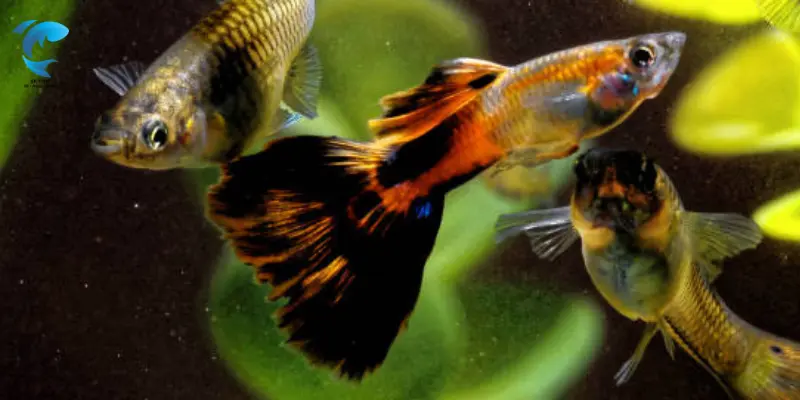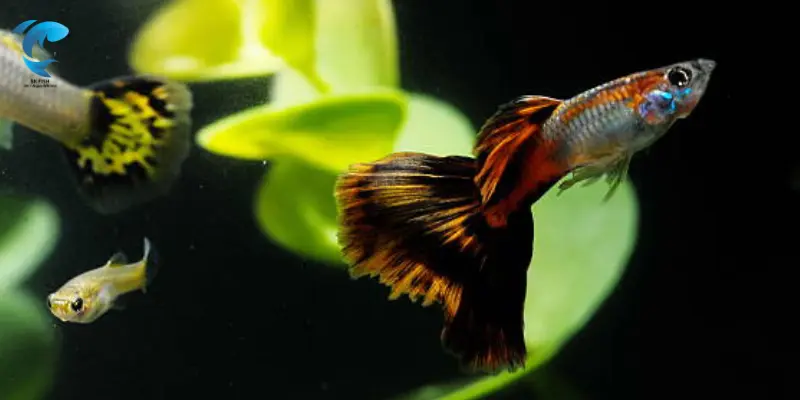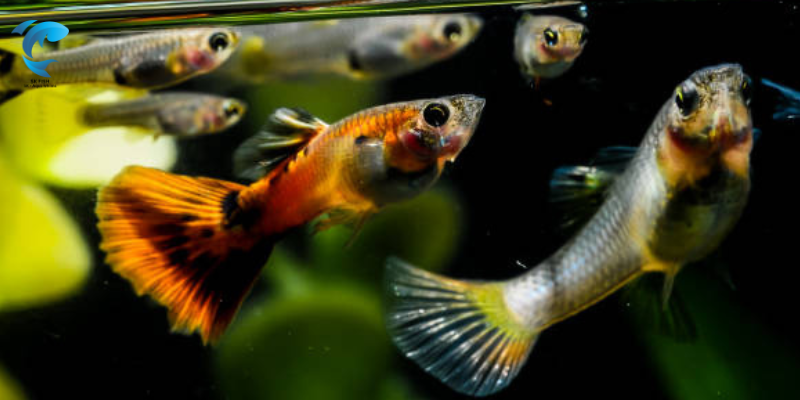Discover the Truth: How Long Does It Take for Guppies to Breed? [Expert Tips Inside]
Published: 4 Jul 2025
Many aquarium enthusiasts struggle to understand the breeding timelines of guppies, which can often result in overcrowded tanks or missed breeding opportunities. However, with a comprehensive understanding of when guppies reach maturity, how long does it take for guppies to breed, and the frequency of breeding, fish keepers can avoid unexpected population explosions or breeding failures.
This knowledge empowers them to manage their aquariums more effectively, reducing stress for the fish and increasing the survival rates of the fry.
Complete Guppy Breeding Timeline
Sexual Maturity Development
The journey to reproductive capability varies by sex in guppies:
Male Guppies: Reach sexual maturity at 2 months of age, WebMD. However, some sources indicate that males can start reproducing as early as 6-7 weeks old (Study.com).
Female Guppies reach sexual maturity at 3 months of age, according to WebMD, although they may not carry pregnancies to full term until 4-6 months of age for optimal breeding success.
The Breeding Process Timeline

Phase 1: Courtship and Mating (Day 0)
The breeding process begins when a male guppy chases a receptive female. During mating, the male extends his modified anal fin (gonopodium) to deposit sperm packets into the female’s anal vent. This process typically occurs up to six times during their mating ritual, according to PetMeDaily.
Phase 2: Fertilization and Sperm Storage
One of the most fascinating aspects of guppy reproduction is that females can store sperm for up to one year after a single mating session. This natural marvel allows them to have 6-8 successive pregnancies from a single insemination, potentially producing several hundred fry over this period.
Phase 3: Gestation Period (21-30 Days)
The pregnancy duration varies depending on environmental conditions:
- Standard gestation: 21-30 days under ideal conditions.
- Temperature-dependent: Can range from 20-32 days depending on water temperature and conditions
- Optimal conditions: 28-30 days at 76-78°F (24-25°C) BucePlant
Phase 4: Birth Process (2-6 Hours)
The actual birthing process typically takes 2-6 hours under normal circumstances. Female guppies give birth to 20-60 live fry per batch, with some capable of producing up to 100-200 fry in exceptional cases.
Phase 5: Post-Birth Fertility
Remarkably, female guppies can become pregnant again within hours of giving birth, leading to continuous breeding cycles approximately every 30 days.
Fry Development Timeline

Stage 1: Newborn Fry (0-7 Days)
- Size: About the size of a grain of rice
- Appearance: Nearly transparent with underdeveloped fins
- Behaviour: Immediately swim to the surface to inflate swim bladders
- Nutrition: Survive on yolk sacs for the first 2-3 days, then require infusoria or powdered fry food
Stage 2: Growing Fry (1-4 Weeks)
- Development: Bodies lengthen, fins become more visible
- Coloration: Faint colors may begin to appear
- Feeding: Introduction of baby brine shrimp and crushed flakes
- Sex determination: Can distinguish male from female by week 4
Stage 3: Developing Fry (1-3 Months)
- Appearance: Well-defined fins and tails, bright adult colors emerge
- Behavior: Confident swimming and social interactions begin
- Feeding: Varied diet including high-quality flakes and small pellets
- Sexual maturity: Males begin developing a gonopodium
Stage 4: Juvenile Stage (3-6 Months)
- Appearance: Resemble adults but smaller in size
- Behavior: Social interactions increase, and early mating behaviors in males
- Breeding capability: Females reach sexual maturity at 3 months, with optimal breeding at 4-6 months
Stage 5: Adult Stage (6+ Months)
- Full maturity: Considered fully grown adults
- Breeding prime: Peak reproductive years
- Lifespan: 2-3 years under optimal conditions
Environmental Factors Affecting Timeline

Temperature Effects
- 76-78°F (24-25°C): Optimal for a 2-3 year lifespan with standard breeding cycles
- 82°F (27°C): Accelerates growth and breeding but reduces lifespan to ~18 months.
Nutritional Impact
- Live foods: Feeding breeding adults live foods like brine shrimp and daphnia increases fry production
- Water quality: Regular water changes maintain optimal breeding conditions
Complete Breeding Cycle Summary
From a single mating event, here’s the complete timeline:
- Day 0: Mating occurs
- Days 1-30: First gestation period
- Day 30: First birth (2-6 hours process)
- Day 30+: The female can become pregnant again immediately
- Days 31-60: Second gestation period
- Day 60: Second birth
- This cycle continues every 30 days for up to 6-8 pregnancies from the original mating.
Key Timeline Facts
- Time to sexual maturity: Males 2 months, Females 3 months
- Gestation period: 21-30 days (typically 28-30 days)
- Birth frequency: Every 30 days
- Birthing duration: 2-6 hours
- Fry to adult: 6 months for full maturity
- Sperm storage: Up to 1 year
- Pregnancies per mating: 6-8 successive broods
- Total fry potential: 200-400+ fry per female per year
This continuous breeding cycle makes guppies one of the most prolific freshwater fish species, capable of rapid population growth under favorable conditions. The timeline can be influenced by water temperature, nutrition, water quality, and overall tank conditions, with warmer temperatures generally accelerating all developmental processes. The sheer speed and efficiency of guppy breeding are awe-inspiring.
FAQ: How long does it take for guppies to breed
Several factors can affect how quickly guppies begin breeding, including water temperature, tank conditions, diet, and overall fish health. Warmer water (around 75–82°F or 24–28°C) typically speeds up the breeding cycle. A clean, well-maintained aquarium and a nutrient-rich diet with high-quality flakes, live, or frozen food also support healthy reproduction.
Guppies usually reach sexual maturity between 2 to 3 months of age. However, the exact age can vary slightly depending on genetics and environment. Males tend to mature a little faster than females, and once mature, they are ready to breed continuously.
Signs of active breeding include males constantly chasing and displaying toward females. You may also notice the male’s gonopodium (a modified anal fin used to transfer sperm) attempting to make contact. Females might appear stressed or try to hide. Within a few weeks, a female’s belly will swell, and a dark gravid spot near the rear fin may become visible, indicating pregnancy.
Yes, guppies can breed very frequently, especially in a mixed-sex tank. Females can store sperm and give birth multiple times (up to 6–8 batches) from a single mating. This can quickly lead to overcrowding if not managed. It’s a good idea to separate males and females if you want to control the breeding rate or avoid stressing the females.
While guppies are prolific breeders and don’t require elaborate setups, providing optimal water quality, a balanced diet, and some plant cover or hiding spots help ensure healthier breeding outcomes. Breeding tanks with stable conditions and minimal stress will lead to more frequent and successful pregnancies.

SK Fish is your trusted source for practical fish care tips and delicious seafood recipes. Our team is dedicated to providing reliable, well-researched content for fishing enthusiasts and home cooks alike.

- Be Respectful
- Stay Relevant
- Stay Positive
- True Feedback
- Encourage Discussion
- Avoid Spamming
- No Fake News
- Don't Copy-Paste
- No Personal Attacks



- Be Respectful
- Stay Relevant
- Stay Positive
- True Feedback
- Encourage Discussion
- Avoid Spamming
- No Fake News
- Don't Copy-Paste
- No Personal Attacks
![The 7 Best Freshwater Fish for Low Light Tanks [Hassle-Free Setup and Maintenance] - Post Thumbnail](https://skfish.com/wp-content/uploads/best-freshwater-fish-for-low-light-tanks-100x67.webp)




